Small Signal Stability with the Householder Method in Power Systems
Abstract
:1. Introduction
2. Materials and Methods
2.1. Mathematical Model of Small Signal Problems
- : Synchronous momentum;
- : Coefficient of synchronous momentum;
- : Damping momentum (has the same phase as ∆ω);
- TD: Coefficient of damping momentum.
2.2. Definition of the Single Machine Infinite Bus (SMBI)
2.2.1. Linearization Model of Equations in Small Signal Stability (Sinδ, Cosδ)
- Tm: Mechanical momentum;
- Ks: Synchronous momentum coefficient.
- Ks: Synchronous momentum coefficient;
- KD = Stabilizer momentum coefficient (stabilizer);
- H = Coefficient of inertia.
- As Ks increases; the natural frequency increases, the stability rate decreases.
- The stability ratio increases as kD increases.
- As H increases, both the ωn rate and the stability rate ζ decrease [30].
2.2.2. Control of Dynamic Systems

2.2.3. Multi-Machine Synchronous Systems
2.2.4. Householder Method Small Signal Stability
3. Results
Evaluation of the Proposed Solution Method
4. Conclusions
Author Contributions
Funding
Conflicts of Interest
References
- Pierre, D.A.; Trudnowski, D.J.; Hauer, J.F. Identifying reduced-order models for large nonlinear systems with arbitrary initial conditions and multiple outputs using Prony signal analysis. In Proceedings of the 1990 American Control Conference, San Diego, CA, USA, 23–25 May 1990; Volume 1, pp. 149–154. [Google Scholar]
- Thompson, S.C.; Ahmed, A.U.; Proakis, J.G.; Zeidler, J.R.; Geile, M.J. Constant Envelope OFDM Abbrev. IEEE MILCOM. Military Commun. Conf. 2008, 56, 1300–1312. [Google Scholar]
- Lindell, G.; Sundberg, C.E.W. An Upper Bound under bir error probability of combine convolution coding and continuous phase modulation. IEEE Trans. Inform. Theory 1988, 1, 1263–1269. [Google Scholar] [CrossRef]
- Khan, S.; Bletterie, B.; Anta, A.; Gawlik, W. On Small Signal Frequency Stability under Virtual Inertia and the Role of PLLs. Energies 2018, 11, 2372. [Google Scholar] [CrossRef]
- Taylor, C.W. Power Systems Voltage Stability; Electric Power Research Institute, McGraw Hill: New York, NY, USA, 1994. [Google Scholar]
- Rajaraman, R.; Dobson, I.; Sarlashkar, J.V. Analytical modeling of thyristor-controlled series capacitors for SSR studies. IEEE Trans. Power Syst. 1996, 11, 15–32. [Google Scholar]
- Martins, N. Retuning Stabilizers for the North-South Brazilian Interconnection. In Proceedings of the 1999 IEEE Power Engineering Society Summer Meeting, Edmonton, AB, Canada, 18–22 July 1999; Volume 1, pp. 58–67. [Google Scholar]
- Lui, W. Research on a Small Signal Stability Region Boundary Model of the Interconnected Power System with Large-Scale Wind Power. Energies 2015, 8, 2312–2336. [Google Scholar] [CrossRef] [Green Version]
- Xu, Y. Stochastic Small Signal Stability of a Power System with Uncertainties. Energies 2018, 11, 2980. [Google Scholar] [CrossRef]
- Parashar, M.; Mo, J. Real Time Dynamics Monitoring System (RTDMSTM): Phasor applications for the control room. In Proceedings of the 42nd Annual Hawaii International Conference on System Sciences (HICSS-42), Big Island, HI, USA, 5–8 January 2009; Volume 1, pp. 5–8. [Google Scholar]
- Abe, S.; Isono, A. Determination of power system voltage stabilitiy. Electr. Engeland Jpn. 1983, 103, 3–13. [Google Scholar]
- Hauer, J.F. Application of Prony analysis to the determination of modal content and equivalent models for measured power system response. IEEE Trans. Power Syst. 1991, 6, 1062–1068. [Google Scholar] [CrossRef]
- Bourgin, F.; Testud, G.; Heilbronn, B.; Verseille, J. Present Practics and Trends on the French Power System to Prevent Voltage Collapse. IEEE Trans 1993, 8, 3–13. [Google Scholar]
- Willems, J.L. Stability Theory of Dynamical Systems; Wiley Interscience Division: London/Nelson, UK, 1970. [Google Scholar]
- Chi-Tsong, T.C. Linear Systems Theory and Design; Academic Press: New York, NY, USA; London, UK, 1984. [Google Scholar]
- Che, Y.; Xu, J.; Shi, K.; Liu, H.; Chen, W.; Yu, D. Stability Analysis of Aircraft Power Systems Based on a Unified Large Signal Model. Energies 2017, 10, 1739. [Google Scholar] [CrossRef]
- Dher, D.K.; Doolla, S.; Bandyopadhyay, S. Electrical Power and Energy Systems Effect of placement of droop based generators in distribution network on small signal stability margin and network loss. Int. J. Electr. Power Energy Syst. 2017, 88, 108–118. [Google Scholar] [CrossRef]
- Haung, D.; Chen, Q.; Ma, S.; Zhang, Y.; Chen, S. Wide-Area Measurement—Based Model-Free Approach for Online Power System Transient Stability Assessment. Energies 2018, 11, 958. [Google Scholar] [CrossRef]
- Berrou, C.; Glavieux, A.; Thitimajshima, P. Near Shannon-Limit error correcting coding and decoding: Turbo codes. Proc. ICC93 1993, 3, 1064–1070. [Google Scholar]
- Bezerra, H.L.; Martins, N. Eigenvalue methods for calculating dominant poles of a transfer function and their applications in small-signal stability. Appl. Math. Comput. 2019, 347, 113–121. [Google Scholar] [CrossRef]
- Anderson, J.B.; Aulin, T. Digital Phase Modulation; Electronics & Electrical Engineering, Applications of Communications Theory; Springer Science & Business Media: New York, NY, USA, 1986. [Google Scholar]
- Khodadad, A.; Divshali, P.H.; Nazari, M.H.; Hosseinian, S.H. Small-signal stability improvement of an islanded micro grid with electronically-interfaced distributed energy resources in the presence of parametric uncertainties. Electr. Power Syst. Res. 2018, 160, 151–162. [Google Scholar] [CrossRef]
- Bourgin, F.; Testud, G.; Heilbronn, B.; Verseille, J. Present practices and trends on the French power system to prevent voltage collapse. IEEE Trans. PWRS 1993, 8, 3–13. [Google Scholar] [CrossRef]
- Hill, D.J. Nonlinear dynamic load models with recovery for voltage studies. IEEE Trans. PWRS 1993, 8, 1. [Google Scholar] [CrossRef]
- IEEE Special Stability Control Working Group. Static VAR Compensator Models for Power Flow and Daynamic Performance Simulation. IEEE Trans. PWRS 1994, 9, 1. [Google Scholar]
- Robak, S.; Gryszpanowicz, K. Rotor angle small signal stability assessment in transmission network expansion planning. Electr. Power Syst. Res. 2015, 128, 144–150. [Google Scholar] [CrossRef]
- IEEE Task Force. Proposed Terms and Defin. for Power System Stability. IEEE Trans. 1982, 7, 1894–1898. [Google Scholar]
- Lu, X.; Xiang, W.; Lin, W.; Wen, J. Small-signal modeling of MMC based DC grid and analysis of the impact of DC reactors on the small-signal stability. Electr. Power Energy Syst. 2018, 101, 25–37. [Google Scholar] [CrossRef]
- Xie, R.; Kamwa, D.; Rimorov, D.; Moeini, A. Fundamental study of common mode small-signal frequency oscillations in power systems. Electr. Power Energy Syst. 2019, 106, 201–209. [Google Scholar] [CrossRef]
- Weiyu, W. Virtual Synchronous Generator Strategy for VSC-MTDC and the Probabilistic Small Signal Analysis. IFAC-Pap. Line 2017, 50, 5424–5429. [Google Scholar] [CrossRef]
- Sadhana, G.S. Small Signal Stability Analysis of Grid Connected Renewable Energy Resources with the Effect of Uncertain Wind Power Penetration. Energy Procedia 2017, 117, 769–776. [Google Scholar] [CrossRef]
- Guo, C.; Zheng, A.; Yin, Z.; Zhao, C. Small-signal stability of hybrid multi-terminal HVDC system. Electr. Power Energy Syst. 2019, 109, 434–443. [Google Scholar] [CrossRef]
- Yang, W.; Norrlund, P.; Chung, C.Y.; Yang, J.; Ludin, U. Eigen-analysis of hydraulic-mechanical-electrical coupling mechanism for small signal stability of hydropower plant. Renew. Energy 2018, 115, 1014–1025. [Google Scholar] [CrossRef]

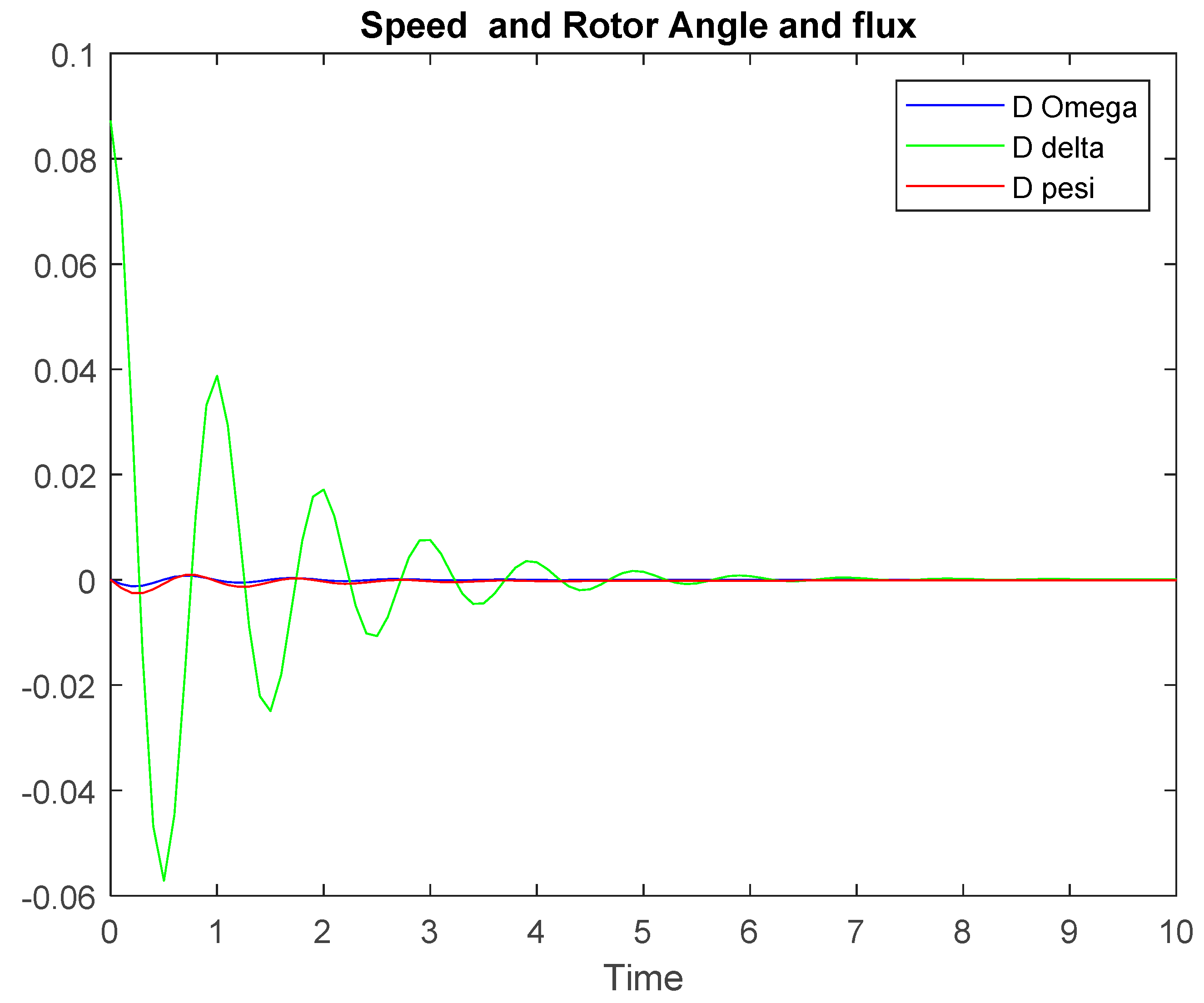
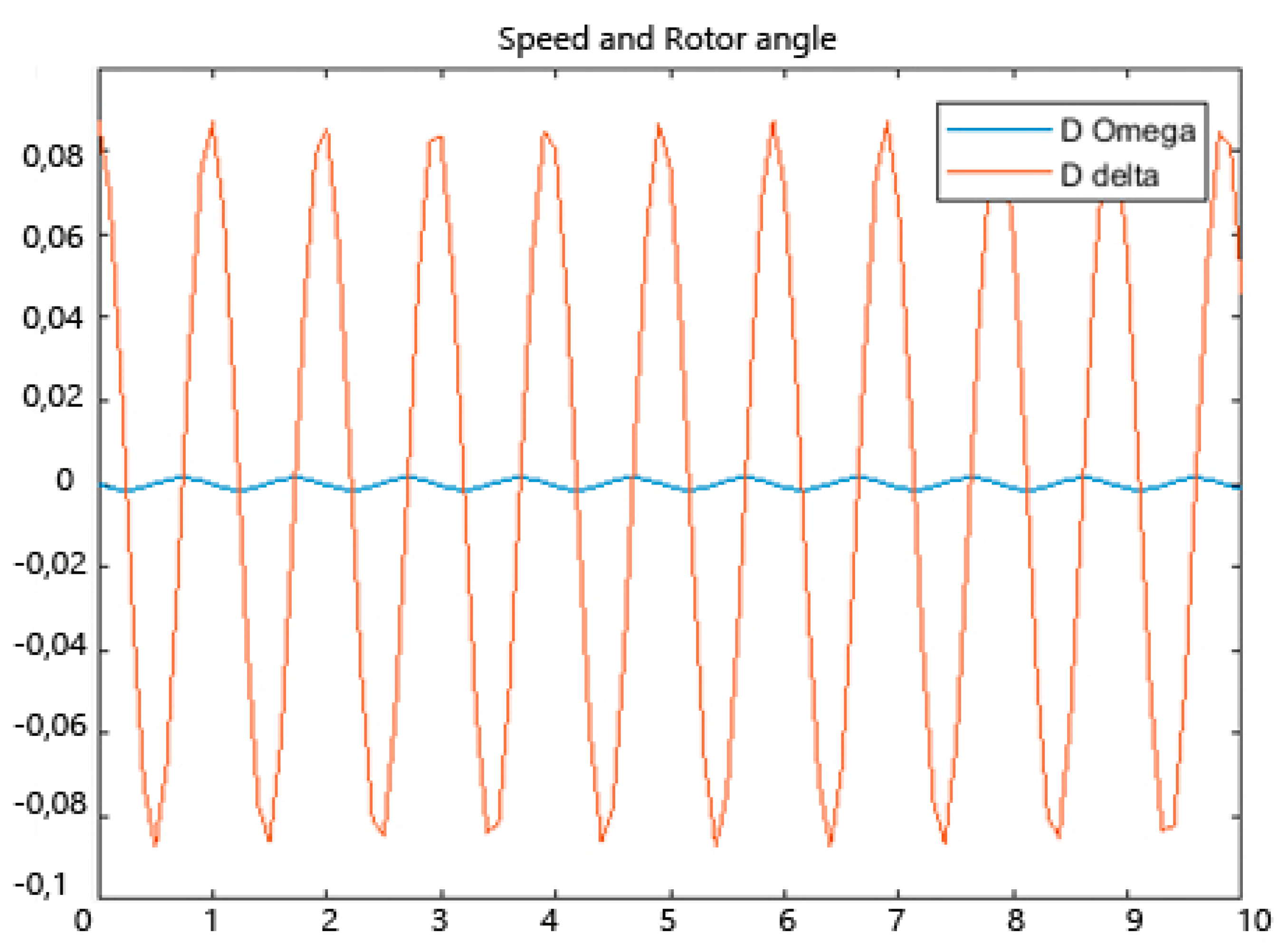

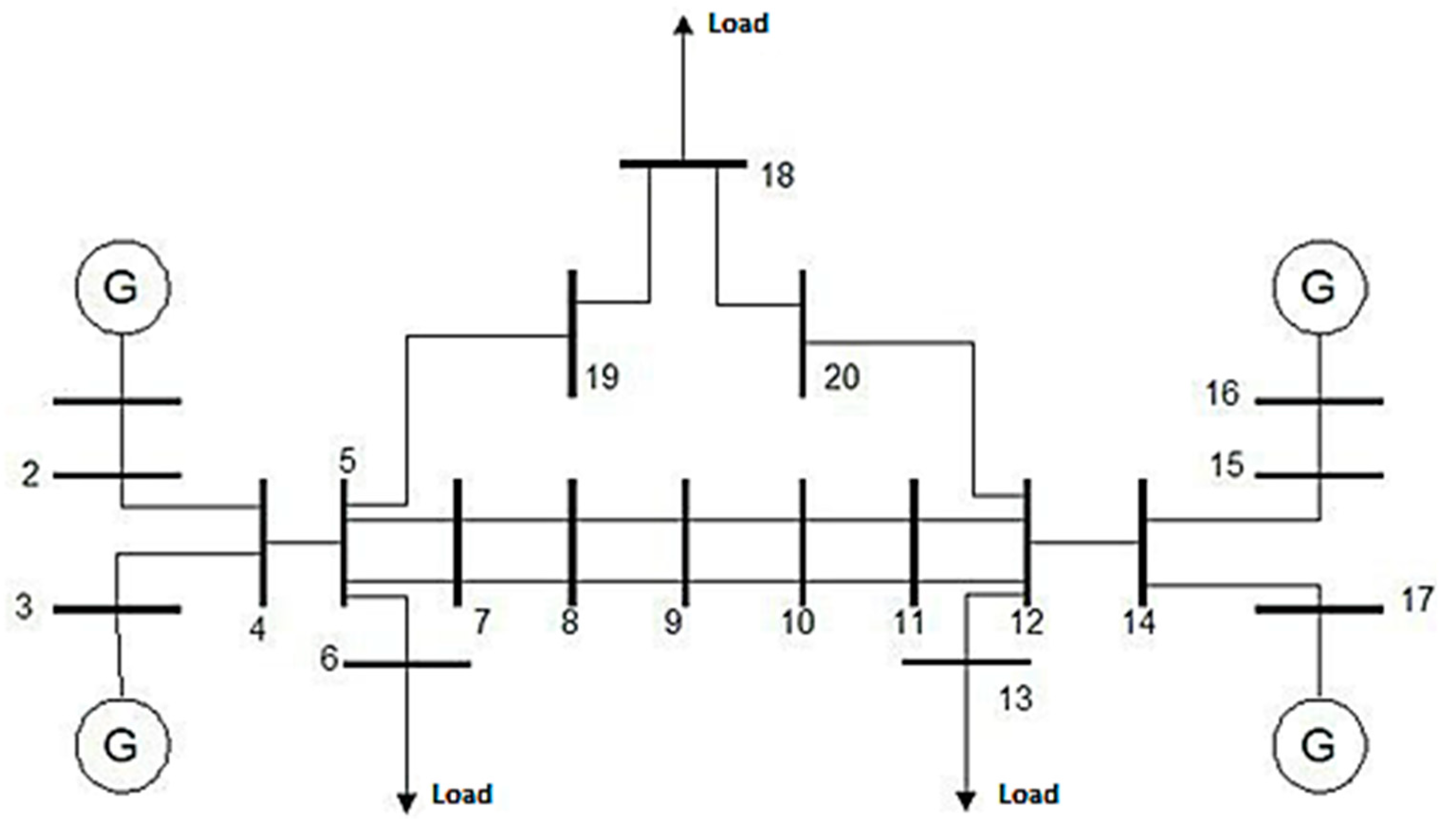
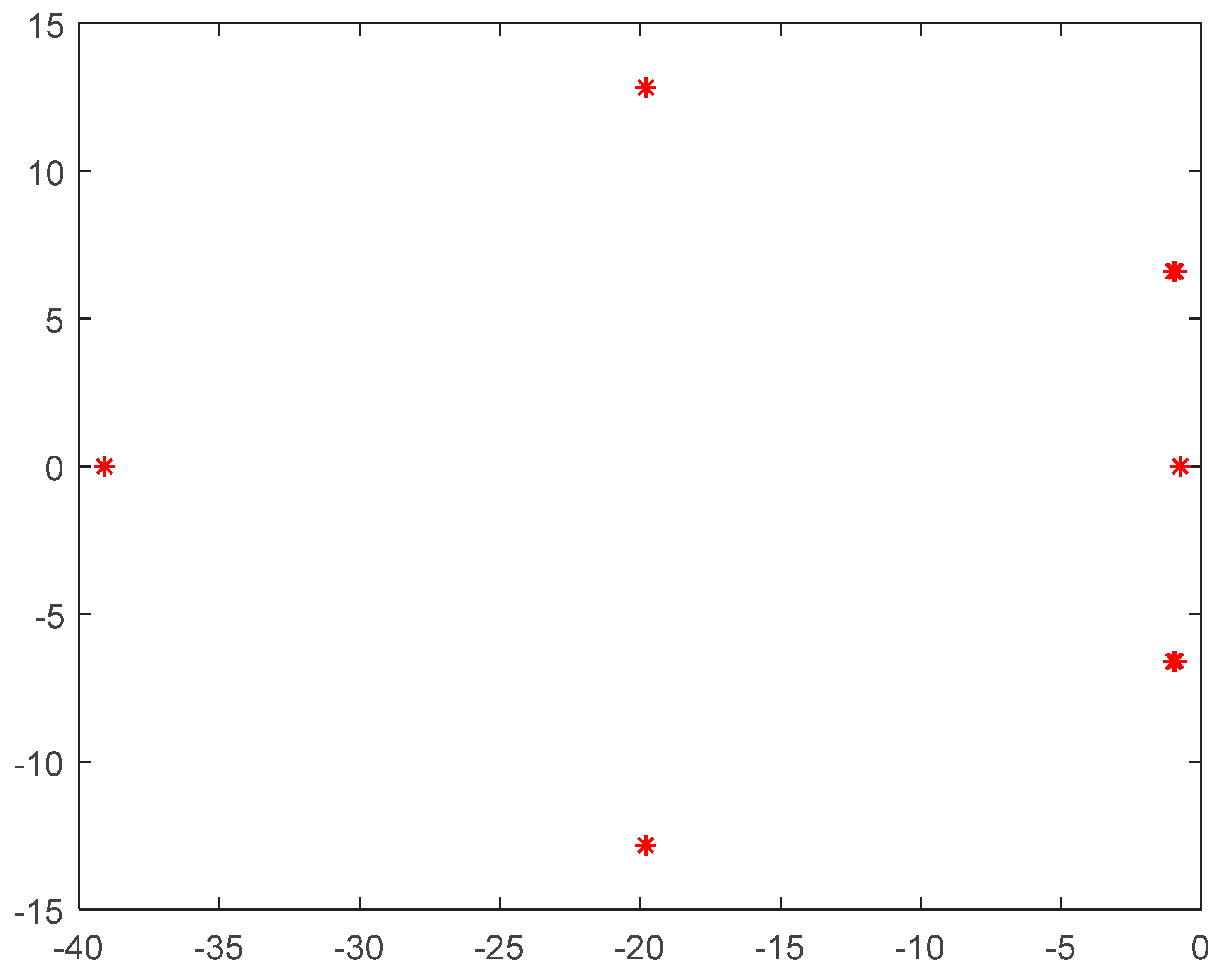
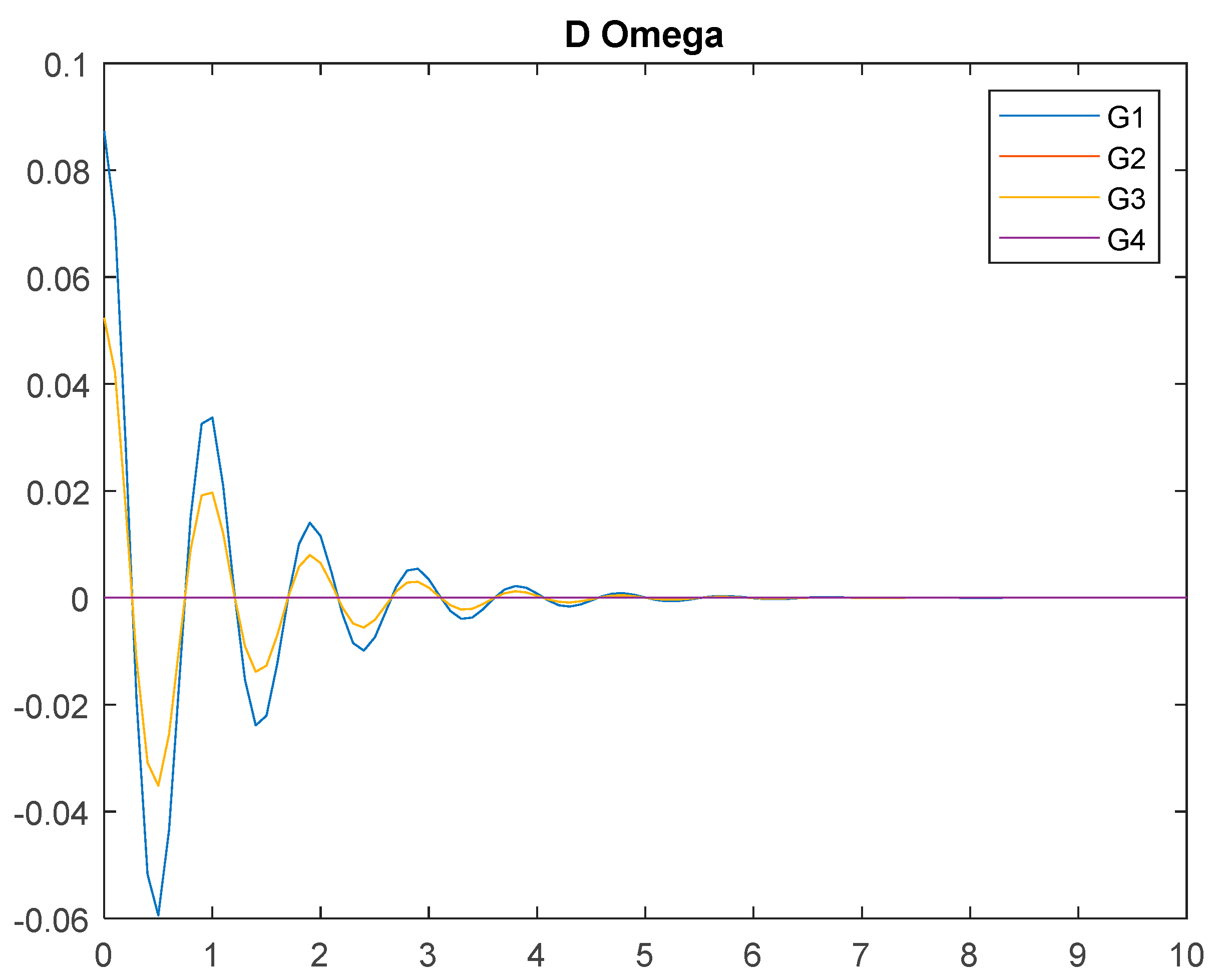

| No. | Real Part | Imaginary Part |
|---|---|---|
| Landa1 | −39.0967416 | +0.000000000000000i |
| Landa2 | −1.00550148 | +6.607284341444071i |
| Landa3 | −1.00550148 | −6.607284341444071i |
| Landa4 | −0.738513482 | +0.000000000000000i |
| Landa5 | −19.79697098 | +12.822376834424755i |
| Landa6 | −19.79697098 | −12.822376834424755i |
| Landa7 | −39.0967416 | +0.000000000000000i |
| Landa8 | −1.00550148 | +6.607284341444071i |
| Landa9 | −1.00550148 | −6.607284341444071i |
| Landa10 | −0.738513482 | +0.000000000000000i |
| Landa11 | −19.79697098 | +12.822376834424755i |
| Landa12 | −19.79697098 | −12.822376834424755i |
| Landa13 | −39.0967416 | +0.000000000000000i |
| Landa14 | −1.00550148 | +6.607284341444071i |
| Landa15 | −1.00550148 | −6.607284341444071i |
| Landa16 | −0.738513482 | +0.000000000000000i |
| Landa17 | −19.79697098 | +12.822376834424755i |
| Landa18 | −19.79697098 | −12.822376834424755i |
| Landa19 | −39.0967416 | +0.000000000000000i |
| Landa20 | −1.00550148 | +6.607284341444071i |
| Landa21 | −1.00550148 | −6.607284341444071i |
| Landa22 | −0.738513482 | +0.000000000000000i |
| Landa23 | −19.79697098 | +12.822376834424755i |
| Landa24 | −19.79697098 | −12.822376834424755i |
© 2019 by the authors. Licensee MDPI, Basel, Switzerland. This article is an open access article distributed under the terms and conditions of the Creative Commons Attribution (CC BY) license (http://creativecommons.org/licenses/by/4.0/).
Share and Cite
Sabati, A.; Bayindir, R.; Padmanaban, S.; Hossain, E.; Rida Tur, M. Small Signal Stability with the Householder Method in Power Systems. Energies 2019, 12, 3412. https://doi.org/10.3390/en12183412
Sabati A, Bayindir R, Padmanaban S, Hossain E, Rida Tur M. Small Signal Stability with the Householder Method in Power Systems. Energies. 2019; 12(18):3412. https://doi.org/10.3390/en12183412
Chicago/Turabian StyleSabati, Asghar, Ramazan Bayindir, Sanjeevikumar Padmanaban, Eklas Hossain, and Mehmet Rida Tur. 2019. "Small Signal Stability with the Householder Method in Power Systems" Energies 12, no. 18: 3412. https://doi.org/10.3390/en12183412






